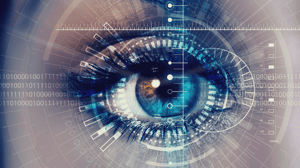An artificial intelligence system has been created in London capable of improving the diagnosis of numerous diseases (high blood pressure, Parkinson's and more) using a retinal exam.
Artificial Intelligence programs based on what is known as “self-supervised learning” (or SSL), which tend to more faithfully mimic the learning processes of the human brain, could, in the near future, facilitate and improve the diagnosis of numerous diseases, such as high blood pressure, diabetic retinopathy and Parkinson's, using retinal exams. The retina, as you may recall, is the thin layer of light-sensitive nerve cells that lines the inside of the eye. It is a type of human tissue that is especially well-suited for helping to make diagnoses, because it is directly connected to the brain and resembles it in numerous ways. It therefore offers a very specific picture of what is happening in the brain tissue. It is also the only tissue that allows us to directly study the capillaries (the smallest blood vessels, within which signs of many diseases can be found) without having to overcome other barriers.
Techniques that use retinal imaging belong to a sector that is swiftly evolving, especially since artificial intelligence (AI) has begun to lend its support, despite still being encumbered with a number of technical limitations. For example, to train a traditional program to distinguish between a healthy retina and a diseased one, it must be provided with millions of clearly identified images, each with its own accompanying “label” describing the situation it depicts (healthy retina/diseased retina). This is a very expensive task and a long one, which requires a lot of work-hours by humans in its early stages. Self-supervised learning, however, is a technology that allows an AI to learn without requiring labels or explicit annotations.
A system that in the same way as Chat GPT learns by itself
Utilizzando questi sistemi i ricercatori del Moorfields Eye Hospital di Londra hanno messo a punto un sistema chiamato RETFound, che apprende molto più velocemente e “da solo”.
Come funziona? «Il sistema - scrive la rivista scientifica Nature, che ha pubblicato i risultati dello studio dei ricercatori britannici - si basa su un metodo simile a quello utilizzato per addestrare modelli linguistici di grandi dimensioni come ChatGPT». Nel caso di ChatGPT l’intelligenza artificiale sfrutta una miriade di esempi di testo generato dall’uomo per imparare a prevedere, in una frase, la parola successiva, basandosi sul contesto delle parole precedenti. «Allo stesso modo - spiega Nature - RETFound utilizza un grandissimo numero di foto della retina (1,6 milioni) per imparare a prevedere come dovrebbero apparire le parti mancanti delle immagini».
High-precision answers
The results have been extremely positive. On a scale where zero represents the inability to make a distinction, 0.5 is the coincidental discovery of a correct answer, and 1 is a correct answer that is the result of a deductive procedure, it has been found that, in the case of diabetic retinopathy, RETFound scores between 0.882 and 0.943, depending on the quantity and type of images provided. In the case of systemic diseases such as high blood pressure, heart failure or Parkinson's, it is less efficient in its predictions, due to the complex nature of the data, but nonetheless superior to traditional AI systems.
As underscored in another review of the study, published in the same issue of Nature [], the importance of this work, among the very first to have demonstrated the potentialities of SSL systems, is that it constitutes a paradigm, a model to use as inspiration to train other SSL systems to perform diagnoses in a way that is non-invasive and highly reliable, starting from retinal images acquired through routine examinations.
More articles on artificial intelligence:
AI takes care of dysphonia (ibsafoundation.org)
More precise mammograms with artificial intelligence (ibsafoundation.org)
Can artificial intelligence become depressed? (ibsafoundation.org)
Mosquitoes: AI sheds light on their behaviour (ibsafoundation.org)
Artificial intelligence in medicine goes straight to the heart (ibsafoundation.org)
AI designs super-antibiotics (ibsafoundation.org)



